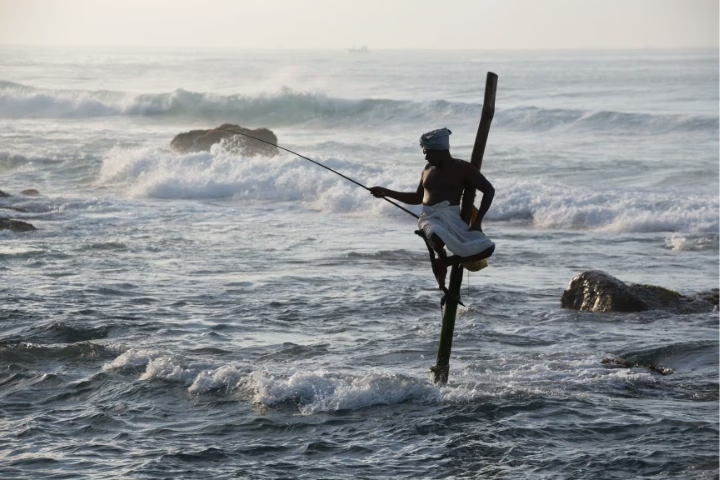TL;DR: The stilt fisherman of Koggala represent one of Sri Lanka’s most iconic and unique fishing traditions. These skilled fishermen perch on wooden poles along the southern coast near Galle to catch fish in shallow waters using techniques their ancestors passed down through generations. While tourism has transformed the practice from purely practical fishing to a cultural experience, visitors still witness a fascinating glimpse into Sri Lankan heritage that attracts thousands annually.
Introduction to Koggala’s Stilt Fisherman Sri Lanka Tradition
The stilt fishermen of Koggala create an iconic and picturesque symbol of Sri Lanka’s coastal heritage along the southern coast near the village of Koggala. These fishermen practice a unique and traditional fishing method that their families have perfected over generations. This remarkable fishing technique exists nowhere else in the world and has become synonymous with Sri Lankan culture, making it one of the most photographed scenes on the island.
Travel brochures, postcards, and even currency notes have featured the image of a lone stilt fisherman silhouetted against the golden sunset, establishing it as one of Sri Lanka’s most recognizable symbols. No other country practices this type of fishing, making it an integral part of local culture, with the famous stilt fishermen gracing older versions of the 20 rupee banknotes.

The Art and Technique of Stilt Fisherman Sri Lanka
Physical Demands and Skills Required
While stilt fishermen create an impression of comfort, stilt fishing actually demands considerable physical strength and endurance. The crossbar on the stilt allows fishermen to sit a few meters above the water while casting minimal shadows. Fishermen practice this age-old tradition unique to Sri Lanka along the southern coastal areas, and though it appears simple, practitioners clearly need exceptional skill and balance.
The technique requires extraordinary balance, patience, and years of practice to master. Fishermen maintain their position on narrow wooden poles for hours, often battling challenging weather conditions while concentrating on catching fish below.
Timing and Fishing Practices
Fishermen conduct stilt fishing in the early morning, usually continuing until 9 am, and in the late afternoon around 4 pm, because fish come close to shore in the morning and return to deep sea during sundown. The fishermen begin at 5am and work through the day for up to four hours at a stretch, storing their catch in a bag they tie to their waist or pole.
The practice demands incredible patience and silence to avoid frightening the fish. During peak season, particularly in April, these dedicated fishermen maintain their positions with remarkable stillness and concentration.
Best Times to Visit Stilt Fisherman Sri Lanka in Koggala
Seasonal Considerations
Visitors can typically observe stilt fishermen on Sri Lanka’s southwestern coast, especially around Galle, just off the main coastal road between Unawatuna and Weligama. Fishermen practice more commonly during the dry season, from October to April.
The dry season provides the best conditions for both fishing and tourism, offering calmer seas and clearer skies that create optimal viewing opportunities. April marks the peak fishing season.
Ideal Viewing Hours
Photographers and tourists find the most spectacular viewing times during sunrise and sunset when stilt fishermen, perfectly balanced on their stilts, patiently maintain silence and stillness while painting stunning silhouettes against a beautiful sunset’s glow, creating a spectacular sight to behold.
The Evolution of Stilt Fisherman Sri Lanka: From Tradition to Tourism
Historical Significance
The tradition of stilt fishing in Koggala has developed deep historical roots, offering a practical solution for fishing in shallow coastal waters where boats couldn’t easily navigate. This ingenious method allowed fishermen to access fish-rich areas while minimizing their shadow on the water, which could frighten potential catches.
Modern Tourism Reality
As we write this article (August 2025), stilt fishing has lost its practical purpose and now primarily serves as a photo-op activity for cash generation. Tour operators and individual tourists can hire ‘fishermen’ for a fee, who then climb onto their stilts.
For a small fee, travelers can climb onto the stilts and capture a piece of history, with Loku Thaththa himself, along with his apprentices, taking to the waters to strike poses that resonate with Koggala’s essence.
Cultural Impact and Photography Opportunities
The stilt fisherman has evolved beyond just a fishing method into a cultural symbol that represents Sri Lanka’s connection to the sea and traditional ways of life. The practice attracts photographers from around the world, who find inspiration in the striking visual appeal of silhouetted figures against dramatic coastal backdrops.
Professional and amateur photographers discover endless inspiration in capturing these moments, whether they focus on the fishermen’s concentration, the graceful lines of stilts against the horizon, or the interplay of light and shadow during golden hour.

Visiting the Stilt Fisherman Sri Lanka Experience
What to Expect
Modern visitors to Koggala can witness this traditional practice firsthand, though they should understand that today’s experience largely represents a cultural performance rather than active fishing. The experience maintains its authenticity in technique and cultural significance, even though tourism has replaced sustenance as the primary motivation.
Tourist Participation
Many operators offer tourists the opportunity to try stilt fishing themselves, providing a unique hands-on experience of this challenging technique. Under careful supervision, visitors can attempt to balance on the stilts and understand the skill this traditional practice requires.
Respectful Tourism
Visitors should approach the experience with respect for both the cultural tradition and the individuals who demonstrate it. The stilt fisherman preserve an important part of Sri Lankan heritage, and tourism helps ensure this knowledge continues passing to future generations.
Conservation of the Tradition
Despite its evolution from practical fishing to cultural tourism, the stilt fishing tradition faces challenges in maintaining authenticity and ensuring younger generations learn the skills. The tourism industry plays a crucial role in providing economic incentive for preserving these traditional techniques.
Local communities and tourism boards work together to maintain the balance between commercial viability and cultural preservation, ensuring visitors can experience this unique aspect of Sri Lankan heritage while supporting local livelihoods.
Getting to Koggala and Planning Your Visit
Koggala offers easy access from major tourist centers like Galle and Unawatuna, sitting conveniently along the main coastal road. The village provides various accommodation options and serves as an excellent base for exploring the southern coast’s attractions.
Local tour operators or the fishermen themselves arrange most stilt fishing demonstrations. Early morning and late afternoon visits provide the best lighting conditions and most active periods for observations.
Conclusion
The stilt fisherman of Koggala represents one of Sri Lanka’s most enduring and visually striking cultural traditions. While tourism has transformed the practice from a purely subsistence activity to a cultural experience, it continues captivating visitors with its unique technique and scenic beauty. This ancient fishing method, which exists nowhere else in the world, offers visitors a window into Sri Lankan coastal heritage and provides an unforgettable photographic and cultural experience.
Whether the spectacular visual appeal, cultural significance, or challenge of trying it yourself draws you, the stilt fisherman tradition in Koggala remains one of Sri Lanka’s must-see attractions. When you witness these skilled practitioners maintaining their balance on narrow poles against the Indian Ocean’s backdrop, you experience a living piece of history that continues defining Sri Lankan coastal culture.
The preservation of this tradition through responsible tourism ensures that future generations will continue marveling at the skill, patience, and artistry of Koggala’s stilt fisherman, making it an essential stop on any journey through Sri Lanka’s magnificent southern coast.




